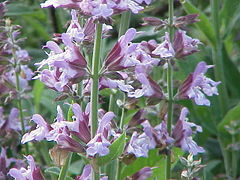Common sage
| Common sage | ||||||||||||||
|---|---|---|---|---|---|---|---|---|---|---|---|---|---|---|
 flowers
|
||||||||||||||
| Scientific classification | ||||||||||||||
|
||||||||||||||
| Binomial name | ||||||||||||||
| Salvia officinalis L. |

Common sage (Salvia officinalis) is a small perennial evergreen subshrub, with woody stems, grayish leaves, and blue to purplish flowers. It is native to the Mediterranean region and commonly grown as a kitchen and medicinal herb or as an ornamental garden plant.
Other common names for this species include: Garden sage, Kitchen sage, and Dalmatian sage. The word sage or derived names are also used for a number of related and non related species.
Contents |
Usage
Common sage is also grown in parts of Europe, especially the Balkans for distillation of an essential oil, though other species, such as Salvia triloba may also be harvested and distilled with it.
Culinary use
As a herb, sage is considered to have a slight peppery flavour. In Western cooking, it is used for flavouring fatty meats (especially as a marinade), cheeses (Sage Derby), and some drinks. In the United States, Britain and Flanders, sage is used with onion for poultry or pork stuffing and also in sauces. In French cuisine, sage is used for cooking white meat and in vegetable soups. Germans often use it in sausage dishes, and sage forms the dominant flavouring in the English Lincolnshire sausage. Sage is also common in Italian cooking. Sage is sautéd in olive oil and butter until crisp, then plain or stuffed pasta is added (burro e salvia). In the Balkans and the Middle East, it is used when roasting mutton.
Medicinal use
The Latin name for sage, salvia, means “to heal". Although the effectiveness of Common Sage is open to debate, it has been recommended at one time or another for virtually every ailment. Modern evidence supports its effects as an anhidrotic, antibiotic, antifungal, astringent, antispasmodic, estrogenic, hypoglycemic, and tonic.[1] In a double blind, randomized and placebo-controlled trial, sage was found to be effective in the management of mild to moderate Alzheimer's disease.[2]
The strongest active constituents of Sage are within its essential oil, which contains cineole, borneol, and thujone. Sage leaf contains tannic acid, oleic acid, ursonic acid, ursolic acid, cornsole, cornsolic acid, fumaric acid, chlorogenic acid, caffeic acid, niacin, nicotinamide, flavones, flavone glycosides, and estrogenic substances.[1]

Toxic in excess or over long periods. Contraindicated during pregnancy and for epilepsy. Caution is indicated when used in conjunction with central nervous system stimulants or depressants.[1]
Cultivars
A number of cultivars of the plant exist. The majority of these are cultivated more often for ornament than for their herbal properties. All are valuable as small ornamental flowering shrubs, and for low ground cover, especially in sunny dry situations. They are easily raised from summer cuttings. Named cultivars include
- 'Purpurascens', a purple-leafed cultivar, considered by some to be strongest of the garden sages,
- 'Tricolor', a cultivar with white, yellow and green variegated leaves,
- 'Berggarten', a cultivar with large leaves,
- 'Icterina', a cultivar with yellow-green variegated leaves,
- 'Alba', a white-flowered cultivar,
- 'Extrakta', has leaves with higher oil concentrations.
- 'Lavandulaefolia', a small leaved cultivar.
Quotes
| “ | Why should a man die whilst sage grows in his garden? | ” |
|
—attributed to Martin Luther |
||
| “ | Why should a man die whilst sage grows in his garden, if not because nothing can stand against death? | ” |
|
—attributed to Hildegard of Bingen |
||
| “ | Cultivate poverty like a garden herb, like sage. | ” |
|
—Henry David Thoreau in the conclusion to Walden |
||
See also
- Thujone
- Essential oil
- Aroma compound
- Salvia
References
- ↑ 1.0 1.1 1.2 "Sage". OBeWise Nutriceutica. Applied Health. Retrieved on 2008-02-04.
- ↑ Akhondzadeh S, Noroozian M, Mohammadi M, Ohadinia S, Jamshidi AH, Khani M. (2003). "Salvia officinalis extract in the treatment of patients with mild to moderate Alzheimer's disease: a double blind, randomized and placebo-controlled trial". J Clin Pharm Ther 28 (1): 53–9. doi:. PMID 12605619.
Sources
- The Herb Society of America New Encyclopedia of Herbs & Their Uses, Deni Bown (New York: DK, 2001)
External links
|
||||||||||||||||||||||||||||||||||||||||||